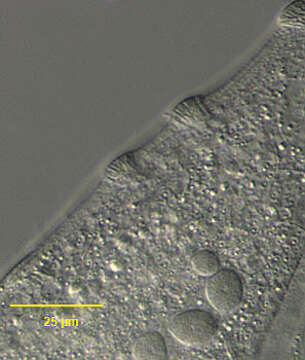Extrusome warts

Kuvaus:
Detail view (dorsal surface) of the large pleurostomatid ciliate, Loxophyllum meleagris (Mueller,1773) Dujardin, 1841. The strongly laterally compressed cell is scimitar-shaped in outline. . The cell is slightly contractile and highly flexible. The rounded anterior end is curved dorsally. The posterior is bluntly tapered. The right side is more densely ciliated than the left. Somatic kineties are longitudinal. The dorsal edge bears characteristic nodular protrusions called extrusome warts (seen well here). The slit-like cytostome is located along the anteroventral edge. There is one posterior contractile vacuole which has a long collecting canal extending anteriorly along the dorsal edge of the cell. The macronucleus (part of which is seen well here) is moniliform. There are multiple inconspicuous micronuclei (not seen here). L.meleagris swims slowly, gliding gracefully over the substrate. L.meleagris feeds on other ciliates and even metazoans such as rotifers. Differentiated from the similar L. helus by its much larger size. Collected from a freshwater agricultural irrigation ditch near McCall, Idaho 9/21/03. DIC.
Mukana seuraavilla sivuilla:
- Life
- Cellular
- Eukaryota (aitotumaiset)
- SAR (Stramenopiles, Alveolates, Rhizaria)
- Alveolata (Alveolaatit)
- Ciliophora (Ripsieläimet)
- Intramacronucleata
- Litostomatea
- Haptoria
- Pleurostomatida
- Litonotidae
- Loxophyllum
- Loxophyllum meleagris
Tämä kuva ei ole esillä missään kokoelmassa.
Lähdetiedot
- lisenssi
- cc-by-nc
- tekijä
- William Bourland
- tarjoaja
- micro*scope
- alkuperäinen
- alkuperäinen mediatiedosto
- käy lähteessä
- kumppanisivusto
- micro*scope
- ID


